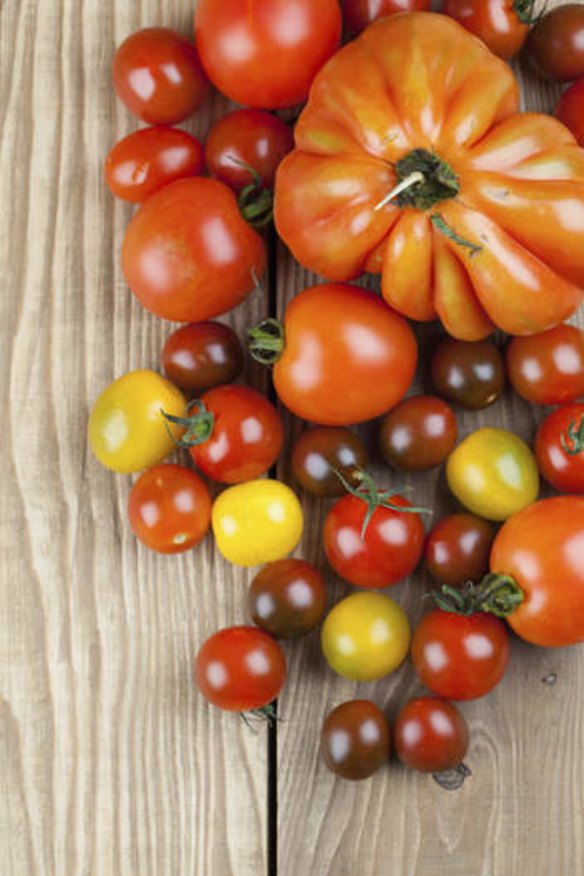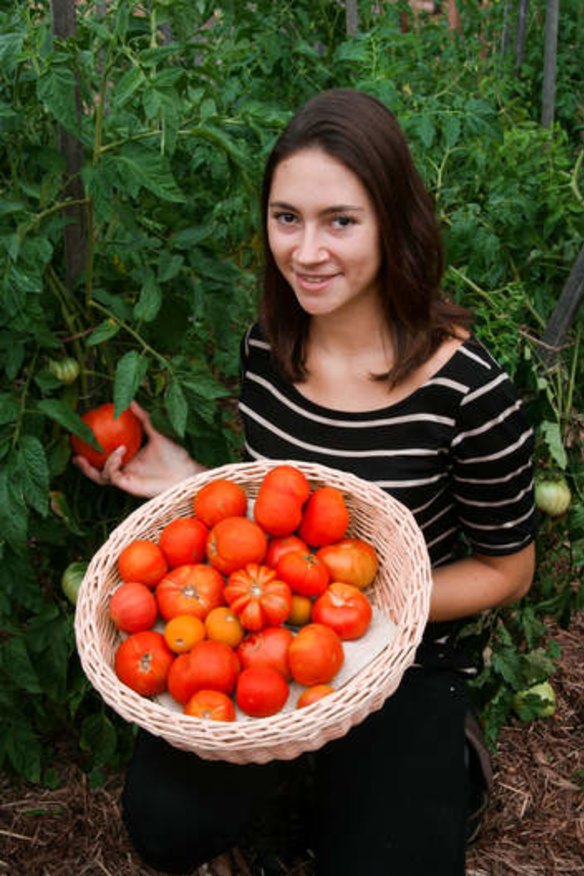Red, juicy rewards

If you have been able to bring your tomatoes through the weeks of heatwave and drought, you have done extremely well.Temperatures over 35 degrees can really knock around ripening tomatoes. Even some of our apples have sunburn.
The tomatoes (and other fruits and vegetables) that came through best were those plants with lots of foliage. The big bright green leaves do so much to provide for a healthy plant.
It is the temperature alone that ripens tomatoes, not being in direct sunlight as such. To have the tastiest tomato, daytime temperatures between 24 and 27 degrees are ideal. Our first main crop has direct morning sunlight but some afternoon shade is provided by two large eucalypts.

We have been giving lots of attention to the large, delicious beefsteak variety. Tomatoes are deep-rooted plants and are heavy feeders. The key to good tomato soil is lots of organic matter – several handfuls of rich compost when we planted the tomato plants out in November and a supplement of seaweed spray each two to three weeks during summer.
The plants need a good air flow and we allowed more space between each plant this summer. It is hard to do. The small plants can grow into large bushes covered with a spreading crop of green fruit.
Another important matter is to mulch well. We mulched in mid-December when the plants were well established, using organic sugar cane mulch. It is readily available, easy to apply and helps to limit weeds, keep the soil temperature down and provide a clean bed for branches that have grown too fast and fallen down, laden with little tomatoes.
And the last contribution to good growing has been to water regularly and deeply. Water bills for city tomato growers have probably gone through the roof. This is essential because if the tomato roots become very dry they cannot absorb calcium and other minerals to produce good fruit. This results in blossom end rot. Tomatoes do not like a stop-start regime with waterings. At a minimum, a weekly deep soak over the garden bed which is well mulched to prevent rapid evaporation loss; in very hot weather two deep soakings are necessary.
Well, there is one other important contributor: people power. When you are growing to supply some of the Canberra market you look for good help. Melanie Soballa has been helping us with vegetable production and orchard work – until a high-profile polo arena offered her a short-term position. She completed much needed tying up of the growing branches, removing laterals, harvesting the ripening crop and packing for market. Many of the early tomatoes are hiding under the foliage so it requires someone with care and attention to find all the ripe tomatoes, especially on the plum and cherry-sized varieties.
But our story today is about those large, royal tomatoes – the family of beefsteak tomatoes. Single slices can sometimes cover a slice of Italian bread. Single, distinguished slices are often served in restaurants as a feature part of fine dining dishes. With each fully grown tomato weighing in between 250 and 350g my target this summer is to be able to pick 10–12 tomatoes from each beefsteak plant. So this has been quite a challenge in one of the hottest, driest summers on record.
College Challenger is a large beefsteak variety with an Australian origin and maturing quite early. The bush can grow to two metres and the tomato has very good flavour. Melanie is shown here picking one of the first ripe tomatoes from these plants from a bush that is carrying a good number of other large, green fruits Red Beefsteak (or Red Ponderosa) is a very productive American variety which produces flattened, slightly ribbed beefsteak sized tomatoes. The flesh is a deep red colour and it has few seeds. You can just imagine a thick slice placed on the top of your T-bone steak for a delectable evening meal.
Mary Italian is a medium-to large-sized beefsteak variety which is quite prolific. The tomatoes have an excellent flavour. Our bushes are carrying four to five large tomatoes at the half metre mark and now have lots of flowers coming for a second flush at the 1.5 metre mark.
Our Hungarian Giant tomatoes have taken longer to produce their first crop but they are currently carrying seven to eight large tomatoes which will soon be ripe.
Rouge de Marmande is an early maturing variety of the beefsteak family. Our plants are generally carrying seven to eight large fruits each. It is a French heirloom dating back to 1925 and the fruit is deep scarlet red in colour, slightly flattened and ribbed. It has very few seeds and the flavour is outstanding. Both cooks and salad makers love this variety.
I have recorded some beefsteak tomato bushes as carrying 12 to 15 large green tomatoes, with two Aussie Reds taking the record with 24 tomatoes on each of the bushes, at this time. Hopefully milder weather will help promote more flowering so that these grand tomato varieties produce well into autumn.
Footnote: I was successful with picking several cherry- and plum-sized tomatoes for Christmas, from the 18 plants which I kept growing in large pots on a north-facing verandah.
This week
■Plant out silver beet and English spinach. Plant out seedlings of brussels sprouts, broccoli and cauliflower.
■Provide regular foliar supplements of seaweed extract or fish emulsion solutions to your garden plants.
■Where you can see that some potato plants have died off, you can harvest the potatoes while allowing the other plants to continue growing and flowering. Dry them well, if you are intending to store for some time. ■If you have planted out leeks or celery, hill up around the base of the growing plants to shield the stems from the hot sun.
■Plant green manure crops where your garden has yielded up its summer crop. For this purpose you could plant clover, mustard, buckwheat, field peas or oats.
■If you have old dead broad bean or bush bean plants, chop them up and dig them back into the garden.
■Check again your ripening pears to see if the pips have turned black. If so, harvest and store in a cool location for 10 to 12 days.
>> Owen Pidgeon owns the Loriendale Organic Orchard near Hall.
Restaurant reviews, news and the hottest openings served to your inbox.
Sign up